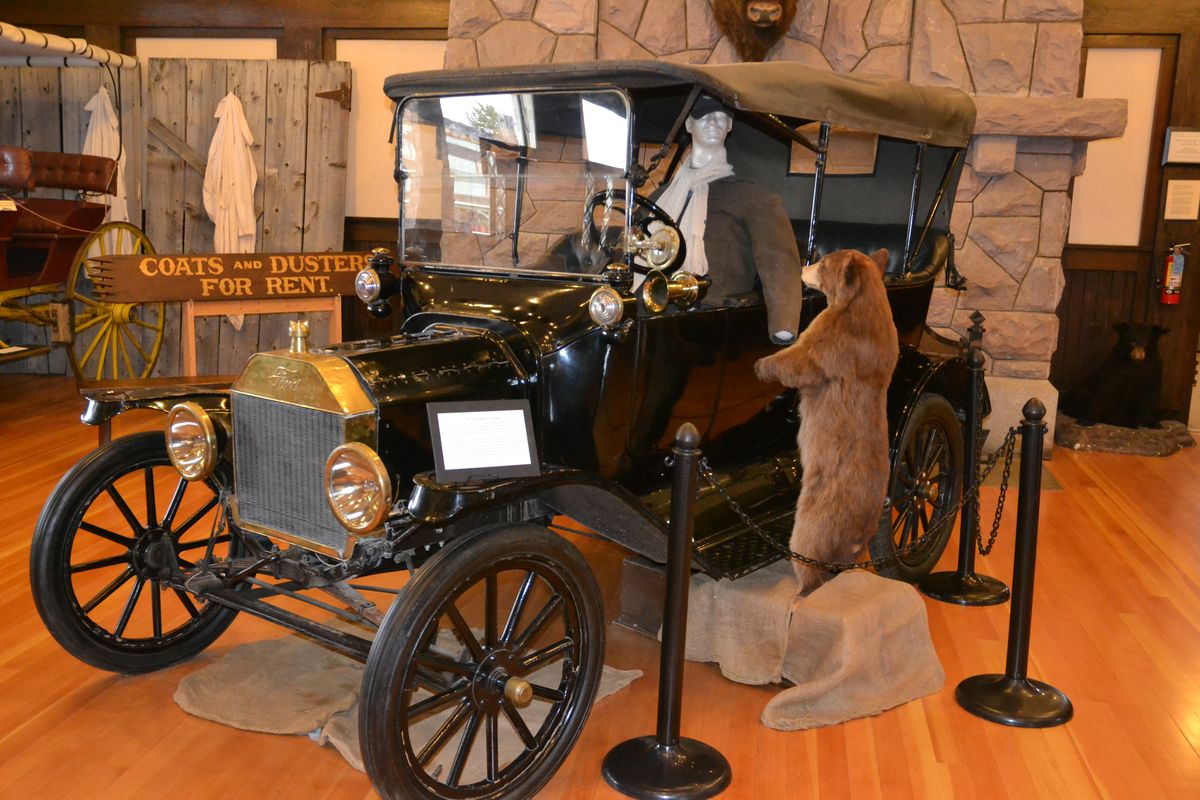Museum of the Yellowstone: The history of West Yellowstone is intertwined with the history of the park
1915 Ford Model T touring cars began arriving and entering Yellowstone National Park in the 1920s. (Mike Brodwater/For The Spokesman-Review)Buy a print of this photo
The town of West Yellowstone in Montana is one of the gateways to Yellowstone National Park. Many people spend the night in town on their way to the park. Understandably, visitors are focused on getting to Old Faithful or the many other natural wonders in the park.
But, the town has a colorful history, which was and always will be interwoven with the park. Find out about the town by visiting the Museum of the Yellowstone. The town of West Yellowstone is high, at 6,660 feet elevation, with a population of 1,016 in 2018.
But during the tourist season, you would guess there are thousands and thousands with all the vacationers passing through town on their way to Yellowstone National Park. The museum, which is open May through October, attracts 20,000 visitors a year.
Yellowstone, the country’s first national park, was established on March 1, 1872. At the time, the only way to access it was by horseback or horse-drawn wagon, and there was no town on the western border.
The Union Pacific Railroad had a “build it and they will come” inspiration to extend their Salt Lake rail line into Idaho and in 1907 added a spur to the edge of the park.
A terminal depot was built, which allowed tourists to disembark the train on one side and on the other side climb into transportation that would take them into the park. The site was rebuilt in 1909 with a more substantial train depot, which now houses the museum.
No town existed, but with the tourists arriving, so did a need for services. Sturdy entrepreneurs and the railroad established businesses near the terminus. The town had succeeding names: Boundary, Terminus, Riverside, Yellowstone, and finally West Yellowstone.
The museum has exhibits and photos detailing the evolution of transportation into the park. Two well-maintained wooden horse-drawn supply wagons represent the way food and other supplies from the trains reached into the tourist facilities at Old Faithful Inn and other areas.
Stagecoaches and other smaller carriages were used to move tourists. Signs offering the rent of coats and “dusters” imply that the trip could be rough, cold and very dusty.
In the 1920s, a dramatic change in transportation occurred when automobiles began arriving. A 1915 Ford Model T touring car represents an introduction of gas-powered vehicles. Later, yellow touring buses were used. With tourists increasingly arriving by car, Union Pacific ended passenger service to West Yellowstone in 1960.
Winter creates totally new transportation issues in the park. In the beginning, winter travel was limited to skis or snowshoes. Even today, roads are not plowed except near Mammoth Hot Springs.
Over-snow vehicles were developed, improved and finally approved by the National Park Service. A vehicle with skis on the front and tracks on the back called a Bombardier was used. It looked like a small tank with skis in front and held seven people. Now, a snow coach with tracks on each wheel that can be traded for tires in the summer is used.
Finally, snowmobiles were introduced. Manufactured by the Bombardier Co. in the 1940s, they were called ski-dogs at first. The name quickly was changed to Ski-Doo, and they, over the years, took over the park. The park service became alarmed by the number of snowmobiles, noise and exhaust pollution of so many machines.
A plan to eliminate all snowmobile travel was proposed, but the gateway towns rose in force against the policy. A compromise was made in 2000 where new four-cycle, less-polluting machines would be used, and snowmobiles entering the park would be required to be with a commercial guide.
The museum also describes notable history that occurred near town. In 1959, a major earthquake shook the area. Twenty miles northwest, a landslide covered a campground and blocked the Madison River. Twenty-eight lives were lost, and thermal features changed in the park. The 1988 fires that lit up the park and the surrounding areas received national attention. These natural disasters can be relived on video.
There is yet more to the history here that is hidden in plain sight. Most visitors go to the train depot and move on not realizing that there is a three-block Union Pacific Railroad Historic District. There are several impressive buildings, and walking tours are offered. They were built in stages after the depot was built by the rail company in the 1920s.
Passengers arriving by train were offered a meal at the beanery. In those days, a beanery offered inexpensive, sit-down food. The service became extremely popular, and Union Pacific hired an architect to design a large dining hall. He used local timber and rock.
The building is massive and beautiful, with a rock fireplace that covers the entire front wall. The ceiling is supported by timbers with a similar design seen in national park structures. It’s huge, with room for hundreds of visitors to eat. Now, the dining hall is used locally for weddings and conventions.
The railroad hired young women from back East to work as servers and other duties. They were called Beanery Queens, and the jobs were much in demand. They also sang to passengers as they exited the train. They worked the entire summer season.
West Yellowstone exists today because of its proximity to the national park. More tourists pass through this town than any other gateway. There is a symbiotic relationship between West Yellowstone the national park. They depend on each other, and their history shows it.







